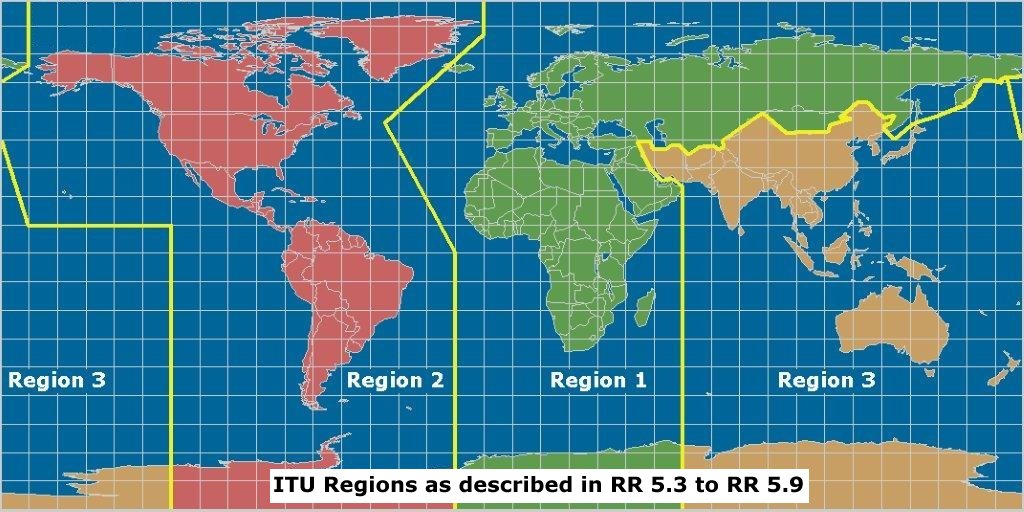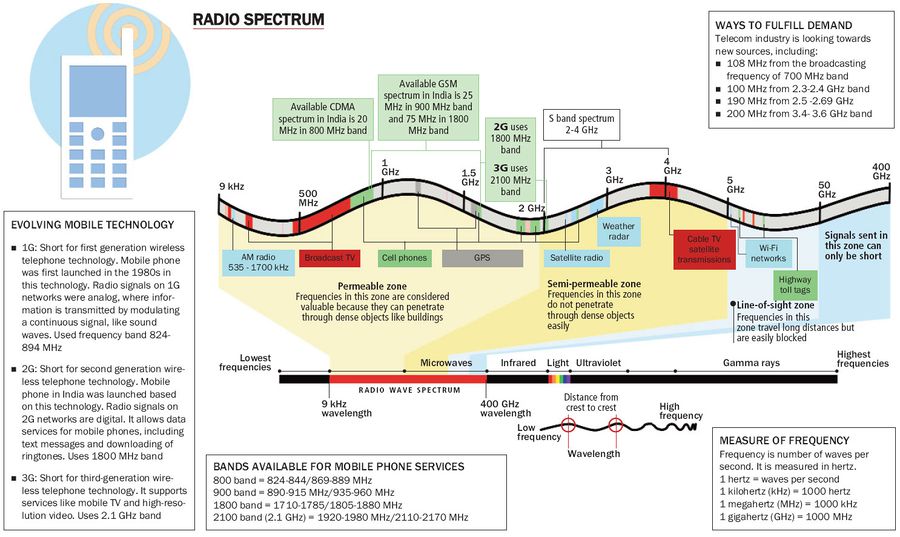Spectrum
Contents
Spectrum
Spectrum is divided into licensed and unlicensed. Licensed spectrum is typically provided to telecom operators who provide voice and data services. End users must obtain these services from a licensed operator and can not use these resources (even for own internal non commercial use ) Unlicensed spectrum can be used by anyone but is subject to stricter limits on power radiated and duty cycle .

As a rule Higher frequency means higher data bandwidth but lesser range. Sub GHZ can more easily penetrate cement walls, tree coverage and at extreme cosmic rays can penetrate deep underground.
- The ITU Defines regions and a global frequency allocation of spectrum. This includes a common ISM( Industry, Scientific and ) band

International ISM bands
ITU defined a industrial, scientific, and medical radio band (ISM band) which is commonly used worldwide. WiFi, Bluetooth etc operate in the ISM band. ITU Frequency Allocation table(FAT) has served well.

This is under stress as capacity is much less then demand and newer technologies like IoT are moving faster then international harmonization efforts.As a result different countries have different allocations.
convergence
https://www.brookings.edu/wp-content/uploads/2016/06/Spectrum-Policy-in-India8515.pdf
National Allocation
The National Frequency Allocation plan (NFAP) 2011 provides for
- 2 MHZ in 865 MHZ band
- 2 MHz in 433 MHz band
for short range communication which can be used for IoT (M2M) It notes
- Ultra Wideband (UWB)
- UWB is a short range low power technology that
will enable a range of applications such as WPANs (information technology / multimedia entertainment / consumer applications), public protection, construction, engineering, science, medical and transportation. Its low energy feature enables unique coexistence properties that allow UWB to operate as an unlicensed wireless technology in presence of other licensed service without causing harmful interference to them. This feature has the effect of increasing spectral efficiency by enabling reuse of spectrum.These devices will also implement next generation cognitive concepts such as Detect and Avoid (DAA) to ensure coexistence with primary users.
- Intelligent Transport System (ITS)
- ITS may be defined as systems
utilizing a combination of computers, communications, positioning and automation technologies to use available data to improve the safety, management and efficiency of terrestrial transport, and to reduce environmental impact. One of the major communication mode in these systems is Digital Short Range communication (DSRC) systems. These devices are mounted on the roadside and the corresponding transceivers are on board the vehicle. Such devices operate over 5-10 MHz bandwidth, with transmit power up to 8 Watts
- E- band Radio
- Developments in millimetre wave radio technology have
caused interest in E-band Wireless as it provides alternative frequency bands for multi-megabit and even gigabit per second speed required by newer generation communication and multimedia services.
| Frequency | Usage |
|---|---|
| 50-200 kHz | Very low power devices 13553-13567 kHz Very low power radio frequency devices, indoor onlycell |
| 26.957 MHz-27.283 MHz | Low power wireless equipment (max. Effective Radiated Power of 5 watts) |
| 335 MHz | Low power wireless equipment for the remote control of cranes |
| 402-405 MHz | Medical RF wireless devices (max. radiated power of 25 microwatt) with channel emission band width within 300 kHzcell |
| 432-438 MHz | Radiolocation Amatuer |
| 865-867 MHz | Low power wireless device (max. transmitter power of 1 watt-4 watts Effective Radiated Power) with 200 kHz carrier bandwidthRadio Frequency Identification Devices (RFID) (MTP of 1 watt-4 watts ERP) with 200 kHz carrier band width |
| 2400 MHz - 2483.5 MHz | Low power wireless equipment (e.g. Wi-Fi) (max. transmitter output power of 1 watt-4 watts ERP) with spectrum spread of 10 MHz or higher |
| 5150 MHz-5350 MHz | Low power equipment for Wireless Access Systems (max. mean Effective Isotropic Radiated Power of 200 mW and max. mean Effective Isotropic Radiated Power density of 10 mW/MHz in any 1 MHz bandwidth) indoor only |
| 5725 MHz-5825 MHz | Low power equipment for Wireless Access Systems (MMEIRP of 200 mW and MMEIRP density of 10 mW/MHz in any 1 MHz bandwidth) indoor only |
| 5825 MHz- 5875 MHz | Low power equipment (MTOP of 1 watt-4 watts ERPower) with spectrum spread of 10 MHz or highercell |
LoRa
LoRa can work with many frequency bands in the ISM band of frequencies, but the popular bands are
- 868 MHz – EU (ITU Region 1)
- 915 MHz – Americas (ITU Region 2)
In India the 865 MHz to 867 MHz license free band in India ends at 867 MHz, as per the Ministry of Communications and Information Technology directions as mentioned here despite being in the ITU. However the 868 MHz LoRa band has 8 channels and 7 of 8 frequency channels are in the license free 865 MHz – 867 MHz band in India.
Cellular spectrum
Military and other uses
Convergence with ITU band others
Licensed Operators
Network Bands Used in India
In India, GSM telephony works on two different frequency bands GSM900 and GSM1800 in MHz(mega hertz). Lower frequency network bands offers higher coverage while higher frequency network bands offers higher data speeds.
HSPA telephony in India works on two different network bands UMTS900 and UMTS 2100 in MHz. UMTS network bands are radio frequencies used by 3G. UMTS network bands in India are commonly deployed at 2100 MHz for better speeds.
LTE Technology in India make use of 3 network bands namely LTE850 (Band 5), LTE1800(Band 3), LTE2300 (Band 40). Band 3 provided great network coverage while Band 40 0ffers greater data speeds.
- https://telecomtalk.info/india-spectrum-data-sheet/134245/
- https://www.frequencycheck.com/countries/india
